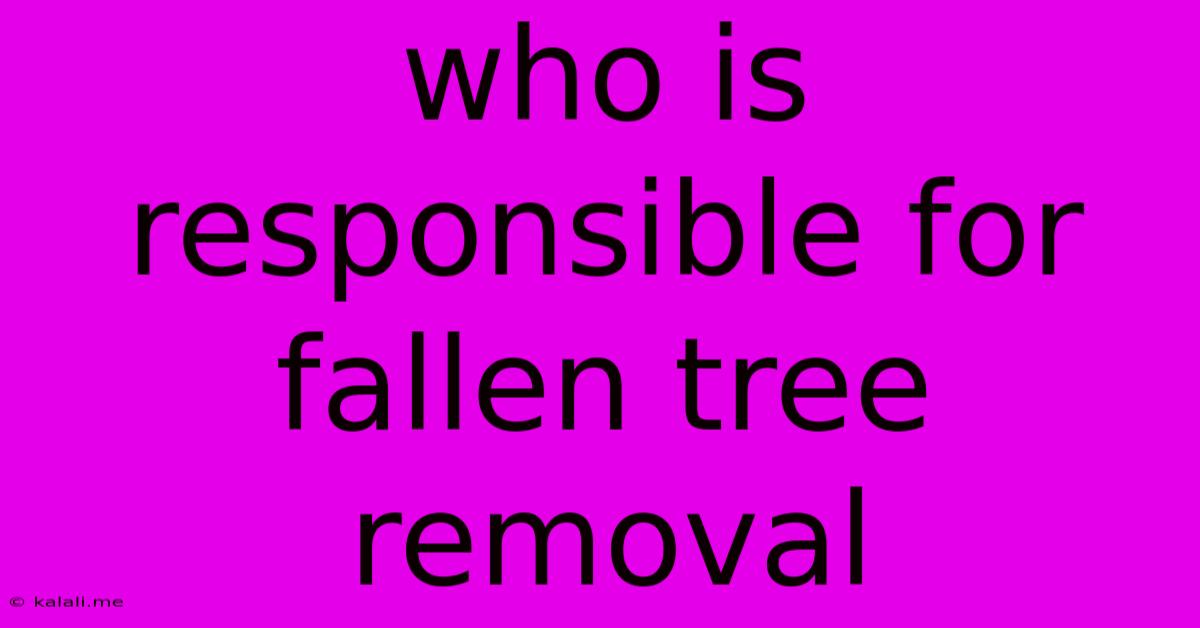Who Is Responsible For Fallen Tree Removal
Kalali
Jun 01, 2025 · 4 min read

Table of Contents
Who is Responsible for Fallen Tree Removal? A Comprehensive Guide
Meta Description: Determining who's responsible for removing a fallen tree depends on several factors, including location, ownership, and the cause of the fall. This guide breaks down liability and clarifies the process.
Falling trees can cause significant damage and disruption, leading to the crucial question: who is responsible for the removal? The answer isn't always straightforward and depends on a number of factors. This comprehensive guide will help you understand liability and navigate the process of fallen tree removal.
Factors Determining Responsibility
Several key factors determine who is responsible for removing a fallen tree:
-
Location of the Tree: Is the tree on public or private property? A tree on private property is generally the responsibility of the property owner, while trees on public land are typically handled by the municipality or relevant government agency. This includes trees on roadsides, parks, or other public spaces.
-
Ownership of the Tree: Even on private property, the ownership of the tree itself might not be clear-cut. For example, a tree might be on a property line, shared by multiple owners, or even encroaching from a neighboring property. Determining ownership is crucial in assigning responsibility.
-
Cause of the Fall: Was the fall due to natural causes (e.g., storm damage, disease, age) or negligence (e.g., inadequate tree maintenance, improper pruning)? If negligence is involved, the responsible party might be liable for damages caused by the fallen tree. This could lead to legal ramifications.
-
Damages Caused: The extent of damage caused by the fallen tree will influence the process. If the tree has damaged a building, vehicle, or power lines, the responsible party will likely need to cover the costs of repair or replacement. This could involve insurance claims.
Scenario Breakdown: Who's Responsible?
Let's break down some common scenarios:
Scenario 1: Tree on Private Property, Natural Fall, No Damage: The homeowner is typically responsible for removing the tree. This is a standard responsibility of property ownership and maintenance. They should contact a local tree removal service for professional assistance.
Scenario 2: Tree on Private Property, Natural Fall, Damage to Neighbor's Property: This is where things get more complex. While the homeowner is generally responsible for maintaining trees on their property, the liability for damage to a neighbor's property might be covered by homeowner's insurance. It is advisable to contact both your insurance company and your neighbor's immediately. Legal advice might be necessary to resolve disputes.
Scenario 3: Tree on Public Property, Natural Fall, No Damage: The local municipality or relevant government agency responsible for maintaining public spaces is responsible for removal. Report the fallen tree to the appropriate department.
Scenario 4: Tree on Public Property, Natural Fall, Damage to Private Property or Vehicle: This often falls under the purview of the municipality's insurance policy. However, the process might involve filing a claim and proving the tree's fall was due to unavoidable circumstances.
Scenario 5: Tree on Private Property, Negligent Maintenance, Damage to Property: If a tree falls due to negligent maintenance (e.g., failure to prune dead branches), the homeowner could be held liable for any damages, potentially facing legal action. This highlights the importance of regular tree inspections and professional maintenance.
Steps to Take After a Fallen Tree
Regardless of who is responsible, taking swift action is crucial after a tree falls:
- Ensure Safety: Prioritize safety. Keep yourself and others away from the fallen tree and any potential hazards.
- Document the Damage: Take photos and videos of the fallen tree and any damage caused. This documentation is vital for insurance claims or legal proceedings.
- Report to Authorities: Report the fallen tree to relevant authorities (e.g., municipality, power company).
- Contact Your Insurance Company: If the fallen tree caused damage to your property or another's, contact your insurance company immediately to initiate a claim.
- Seek Professional Help: Contact a qualified arborist or tree removal service for safe and efficient removal of the fallen tree.
This guide provides a general overview. Specific laws and regulations regarding tree removal vary by location. It's always advisable to seek legal counsel if you face complex situations or disputes regarding responsibility for a fallen tree. Remember, proactive tree maintenance is key to preventing such incidents.
Latest Posts
Latest Posts
-
Can You Bring A Car Seat On A Plane
Jun 02, 2025
-
How Much Body Heat Does A Human Generate
Jun 02, 2025
-
Can The Police Commandeer Your Car
Jun 02, 2025
-
Why Does My Hot Water Only Last 10 Minutes
Jun 02, 2025
-
Failed To Get Canonical Path Of Cow
Jun 02, 2025
Related Post
Thank you for visiting our website which covers about Who Is Responsible For Fallen Tree Removal . We hope the information provided has been useful to you. Feel free to contact us if you have any questions or need further assistance. See you next time and don't miss to bookmark.